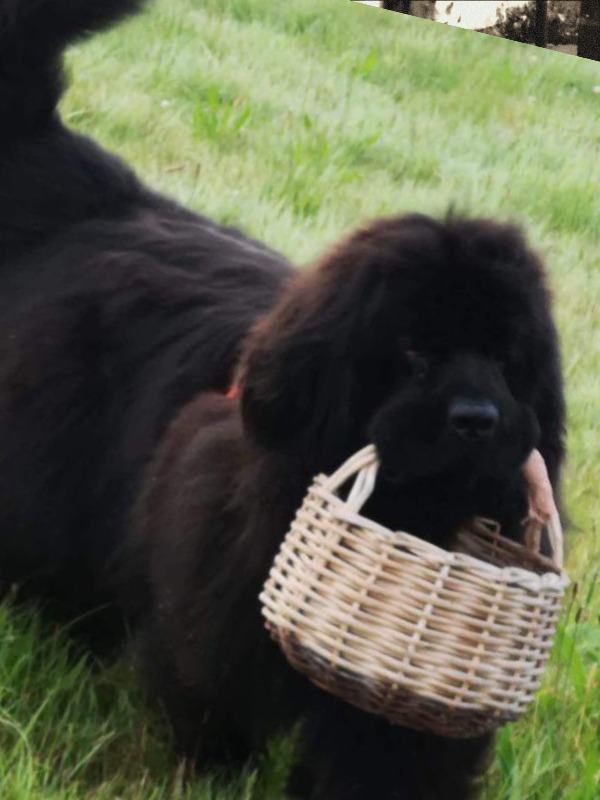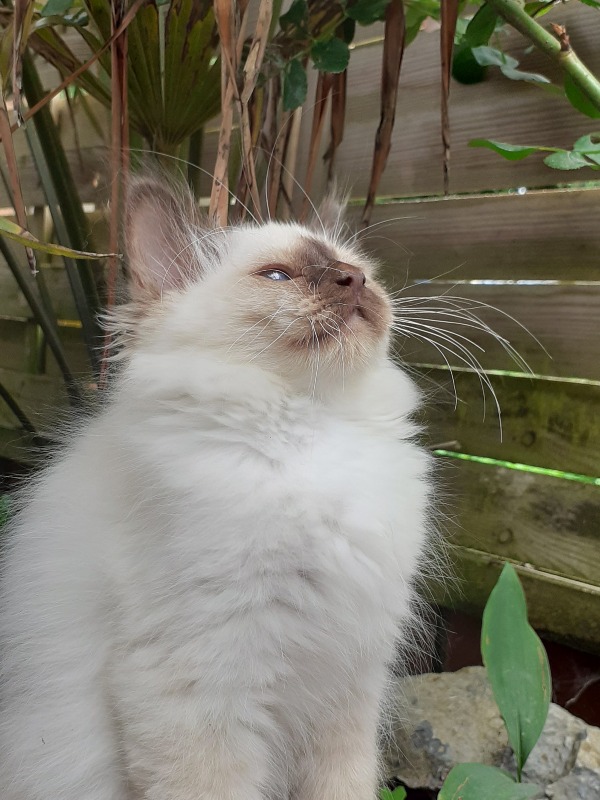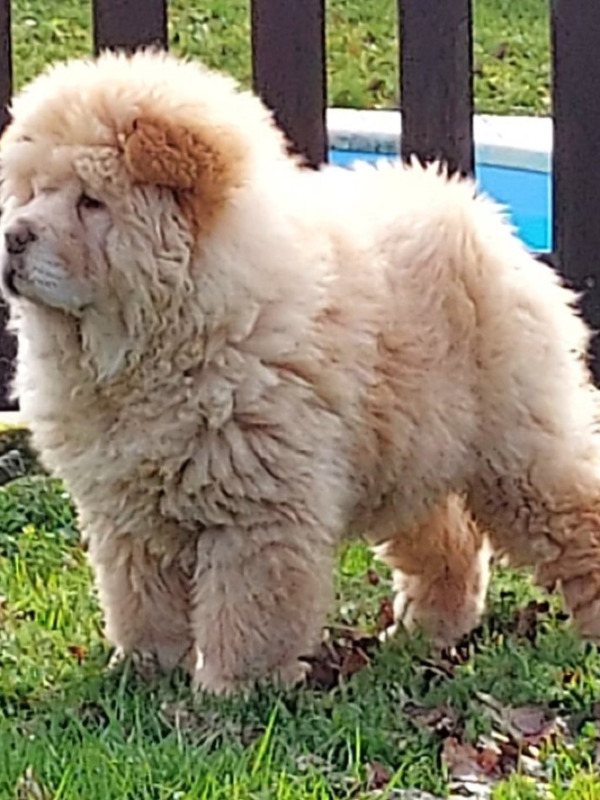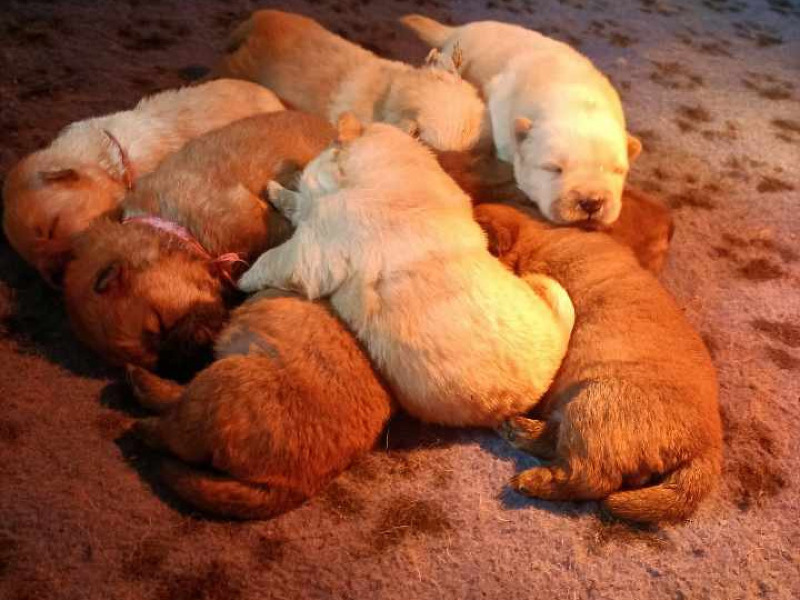Chow-chow
Welcome to our page dedicated to the breed of dog chow-chow!
Here, you will find all the useful information about chow-chow. This descriptive profile will allow you to discover the aspects of this breed. You can notably consult information about the average price, monthly and annual upkeep expenses, their health, name ideas, as well as their official recognition by competent authorities.
Explore this page to discover everything you need to know.
Overall description of the breed
Of Chinese origin, the Chow-chow is a breed with ancestral origins, it would exist since more than 2000 years in China, initially raised for its fur or its meat, it becomes gradually a famous guard dog as well as a hunter particularly appreciated in the Middle Kingdom.
Its exact ancestors are unknown, and China has never communicated on the different crossbreeds used to obtain the Chow-chow's characteristic type. It was imported into England at the very beginning of the 19th century, but it was only in the 1920s that it was officially presented, notably at the Crufts exhibition in 1925. It then enjoyed enormous popular success from the end of the Second World War, and nowadays the Chow-chow is present in most countries of the world.
The Chow-chow was recognized by the FCI on December 10, 1957 under the patronage of the United Kingdom, the last update of the official standard in force was published on October 13, 2010.
The Chow-chow is a medium-sized dog with a very noble appearance, coupled with a rare elegance, it is an enigmatic and attractive animal. Compact and stocky, its appearance is clumsy and its gait heavy, all in roundness, its body is as long as high, inscribable in a square. Straight, with a firm, short and broad back line, solidly built, with a wide rib cage, curved ribs, rounded in a barrel shape, associated with a broad and strong chest.
The head is always massive and round, with a short, cubic muzzle, the stop is not very marked and one of its main characteristics is to have a blue tongue. The tail is of medium length and well furnished with hair, and is carried proudly. Two varieties of hair are distinguished, the short and the long hair, both are smooth, abundant and of cottony texture. The coat colours permitted by the breed standard are black, red, blue, fawn, cream or white, frequently shaded, but not spotted or multi-coloured.
He is not the most demonstrative of dogs, but his attachment to his family and especially to his master is very real. His character is very particular, he appreciates playful games or sharing time with his loved ones, however, he will rarely, if ever, participate in them. Autonomous and solitary, he does not like to be touched all the time or too often solicited, moreover, he is not suitable for small children, agitation or noise will make him run away.
The Chow-chow is really a dog apart, it is necessary to understand it to be able to appreciate it to its just value, it is an independent dog of company, it is enough to itself, but will like to remain near its family to contemplate them. Calm and peaceful, don't be fooled by its big teddy bear appearance, it is a formidable guard dog that will protect its territory as well as its family at all costs.
In conclusion, the Chowchow is a dog with a balanced temperament, never fearful or aggressive, it is a confident companion who will bring you serenity and security in your home.
Adult: The Chowchow will weigh approximately 20-30 kg (44-66 lbs) and will stand approximately 48-56 cm (19-22.5") for males and 46-51 cm (17-20") for females.
Awareness of acquiring an animal
Each animal is a sensitive being, deserving love, attention and care.
When you choose to adopt an animal, you take on the responsibility of ensuring its health and well-being throughout its life.
To learn more about animal welfare, we invite you to consult our FAQ by clicking the button below:
Origins
The Chow-chow, an ancient and majestic breed, finds its origins in China where it has been revered for millennia. The first traces of this breed date back over 2,000 years, and it is often depicted in Chinese art and sculpture. It is believed that the Chow-chow descends from Tibetan war dogs and Mongolian hunting dogs. Historically used for hunting, guarding, and even sled pulling, the Chow-chow is a versatile and robust breed, recognized for its unique appearance and noble character.
History
The history of the Chow-chow is deeply rooted in Chinese culture. This breed was prized by Chinese emperors and members of the nobility for its loyalty and guarding skills. In addition to its roles as a hunter and guardian, the Chow-chow was also used for its fur and meat in some regions. Introduced to Europe in the late 19th century, the Chow-chow quickly gained popularity thanks to its distinctive appearance and reserved yet loyal temperament. Today, it is recognized worldwide and appreciated for both its beauty and unique character.
Standard
The standard of the Chow-chow breed describes a dog of medium size, with a compact and powerful body. Males measure between 48 and 56 cm at the withers, females between 46 and 51 cm. Their weight ranges from 20 to 32 kg. The coat can be smooth or rough, dense and straight, available in several colors: red, black, blue, fawn, cream and white. The head is wide with a short muzzle and a blue-black tongue, a unique characteristic of the breed. The eyes are small and sunken, and the ears are small, thick and carried straight, adding to their dignified and attentive expression.
Physical characteristics
The Chow-chow is a distinctive dog, immediately recognizable by its sturdy silhouette and thick coat. Their wide, flat head with a short muzzle gives them a serious and imposing look. Their blue-black tongue is a unique characteristic among dog breeds. The eyes are small, round, and often hidden under heavy eyebrows, giving them an expression of dignity and concentration. Their tail is carried high and curled over the back. The coat can be smooth or rough, but always dense, effectively protecting against the weather. Colors range from red to black, blue, and cream.
Character
The Chow-chow is known for its independent and reserved character. Loyal to its family, it is often wary of strangers, making it an excellent guard dog. Although protective, it is not aggressive if well socialized from a young age. The Chow-chow is also very intelligent, but can be stubborn, requiring firm and consistent training. It is affectionate with loved ones, but generally prefers cuddles on its own terms. This dog with a calm and dignified temperament adapts well to apartment living, as long as it receives enough daily exercise.
Life expectancy
The life expectancy of Chow-chow is generally between 9 and 15 years, although some may live longer with proper care. This longevity is conditioned by a balanced diet, regular exercise and attentive veterinary care. Just like all breeds, regular visits to the veterinarian are essential to monitor and maintain their health. Chow-chows are prone to certain genetic health conditions, so it is important to work with a reputable breeder who performs health tests on their breeding dogs to minimize these risks.
Exercise and activity needs
Although the Chow-chow is often perceived as a calm dog, it nonetheless requires regular exercise to stay healthy and avoid obesity. Long daily walks and moderate playtime are essential to maintain their physical and mental condition. Despite their reserved nature, they enjoy moments of play and exploration outdoors. It is important to stimulate them mentally with interactive toys and training sessions to avoid boredom. Chow-chows are not hyperactive dogs, but regular daily exercise is crucial for their overall well-being.
Recommended diet
The Chow Chow's diet must be balanced and tailored to their specific needs. A diet rich in high-quality proteins from animal sources such as chicken, beef, or fish is essential to support their musculature. Healthy fats and complex carbohydrates, such as brown rice and vegetables, complement their diet. It is recommended to divide their daily ration into two meals to avoid digestive issues. Special attention should be paid to the quality of food to prevent allergies and food intolerances, which are common in this sturdy but sensitive breed.
Training and obedience
The education of a Chow Chow requires patience and consistency. Their independent and sometimes stubborn nature can make training a challenge, but they respond well to positive reinforcement methods. Training sessions should be short and varied to maintain their interest. Early socialization is crucial to prevent excessive distrust towards strangers and other animals. A well-educated and socialized Chow Chow can be an obedient and well-balanced companion. It is important to establish clear rules from the beginning and to remain firm but fair to develop a relationship of mutual respect.
Behavior with children
The Chow-chow can be an excellent companion for children if well socialized and trained from a young age. It is generally calm and patient, but can become protective of its family. It is essential to teach children to respect the dog and interact with it appropriately. As with any interaction between children and dogs, supervision is recommended to avoid accidents. The Chow-chow enjoys tranquility and may prefer quiet moments to noisy games, but can be affectionate and loyal to the children in its family.
Compatibility with Other Animals
The compatibility of the Chow-chow with other pets largely depends on its early socialization. If introduced to other animals at a young age, it can peacefully coexist with them. However, due to its protective instinct and reserved nature, it can be suspicious or territorial towards newcomers. A gradual and supervised introduction is essential to establish a good relationship. Chow-chows can get along well with cats and other dogs, but since each individual is unique, it is important to carefully observe their interactions.
Grooming needs
Grooming of the Chow Chow is essential to maintain the health and beauty of its dense and luxurious coat. Regular brushing, at least two to three times a week, is necessary to prevent knots and tangles. During shedding periods, daily brushing may be necessary. Baths should only be given when the dog is dirty, as too frequent bathing can irritate its skin. It is also crucial to regularly check and clean its ears, brush its teeth, and trim its nails. Regular grooming helps prevent skin infections and keep the coat in good condition.
Health
The Chow-chow is a robust breed but can be prone to certain health problems, such as hip dysplasia, entropion (eyelid problems), and thyroid disorders. Skin allergies and infections are also common due to their dense coat. It is essential to regularly consult a veterinarian for routine check-ups and monitor any signs of discomfort or changes in behavior. A balanced diet, moderate exercise, and proper preventive care are essential to maintain the health and longevity of the Chow-chow.
Average price
The price of a Chow Chow puppy can vary depending on the breeder, lineage, and region. Generally, you can expect to pay between 1,000 and 2,500 euros (1,100 to 2,700 dollars) for a quality puppy from a reputable breeder. This price often includes initial vaccinations, deworming, and some initial socialization. Responsible breeders also provide health guarantees and are often involved in supporting new owners throughout the dog's life. It is essential to choose a responsible breeder to ensure the health and well-being of the puppy.
Expenses
Annual expenses for a Chow-chow can vary, but a total cost of around 1,000 to 1,500 euros (1,100 to 1,600 dollars) per year can be estimated. This budget includes high-quality food, regular veterinary care, grooming products, toys and accessories, and possibly training classes. Preventive care, such as vaccinations and parasite treatments, are essential for maintaining the dog's health. Owners should also budget for additional expenses for unexpected medical needs or specific needs related to their dog's age or physical condition.
Name ideas
Choosing a name for a Chow Chow can be inspired by its origins and majestic appearance. "Bao" means "treasure" in Chinese, symbolizing the precious value of the dog to the family. "Ming" means "bright", perfect for a dog with glowing fur. "Lian" means "lotus", evoking beauty and purity. "Kai" means "sea", a nod to their calm and serenity. "Lei" means "thunder", indicating their imposing presence. "Hua" means "flower", for their elegance. "Yin" means "silver", "Zhen" means "precious", "Yu" means "jade", and "Shi" means "stone", illustrating their strength and nobility.
Legislation and regulation
The Chow-chow is not subject to any particular restrictions in most countries. It is considered a companion and guard dog, free from the restrictions often imposed on certain breeds considered dangerous. Owners must however comply with local regulations regarding registration, vaccination, and animal control. In some places, it may be necessary to keep dogs on a leash in public spaces and to respect specific rules in parks and recreation areas. Local research is recommended to ensure compliance.
Official recognition
The Chow-chow is recognized by several canine organizations, including the Fédération Cynologique Internationale (FCI) and the American Kennel Club (AKC). The recognition by the FCI allows this breed to participate in international dog shows and benefit from worldwide recognition. The official breed club in China, the Chinese Kennel Club, plays a crucial role in promoting and preserving this unique breed. Other global registries, such as the United Kennel Club (UKC), also recognize the Chow-chow, ensuring standardization of the breed's characteristics on an international scale.
Pedigrees
Chow Chow breeders generally provide detailed pedigrees for their puppies, tracing the ancestry of several generations. These documents are essential to ensure the purity of the breed and check for the absence of inherited health problems. A well-documented pedigree may include information on the working titles, health tests, and distinctions of the ancestors. Potential owners should always ask to see the pedigree before buying a puppy and ensure that the breeder follows ethical and responsible breeding practices aimed at maintaining the quality and health of the breed.
Destination and usage
Historically, the Chow-chow has been used for hunting and guarding homes. Today, it is still appreciated for its protective abilities and role as a loyal companion dog. Due to its vigilant and protective nature, it is often used as a guard dog. Its intelligence and agility also make it a good candidate for canine sports. Chow-chows are devoted companions who integrate well into active and experienced homes. Their heritage of hunting and protection continues to influence their role in modern society.
Prohibitions
The Chow-chow is generally not subject to specific restrictions in most countries. Unlike some breeds considered dangerous or potentially aggressive, the Chow-chow is widely accepted and is not classified in restricted dog categories. However, owners are always advised to check local laws regarding dogs before traveling or moving with their pet. Some regions may have specific regulations on breeds or particular requirements for large dogs, although the Chow-chow, with its protective yet stable temperament, is rarely affected.
Breeders of Chow-chow
Want to see more breeders of Chow-chow?
Check out the page of our directory listing all breeders of Chow-chowClassified Ads of Chow-chow
Breed clubs of chow-chow
No of chow-chow breed clubs are currently registered on Preeders.
If you would like to highlight your breed club, sign up for free now and be the first to appear on this page.







